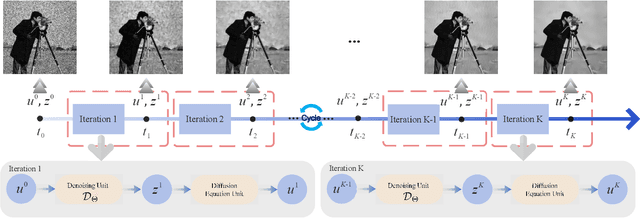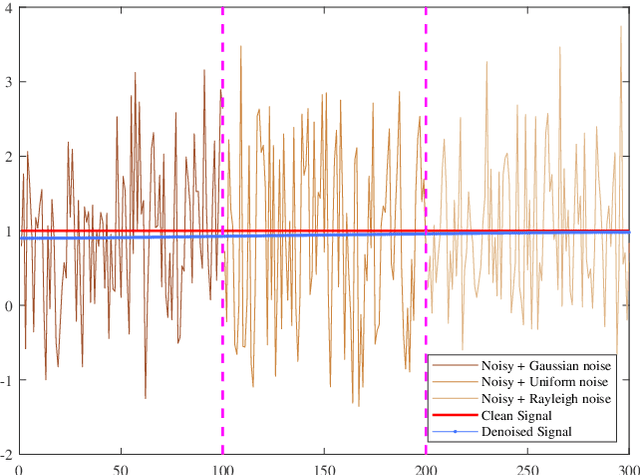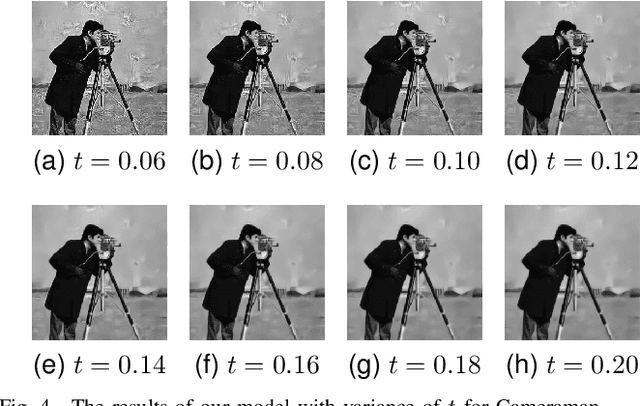Sar Image Despeckling
Synthetic aperture radar (SAR) image despeckling is the process of removing speckle noise from SAR images.
Papers and Code
Bayesian Despeckling of Structured Sources
Jan 21, 2025Speckle noise is a fundamental challenge in coherent imaging systems, significantly degrading image quality. Over the past decades, numerous despeckling algorithms have been developed for applications such as Synthetic Aperture Radar (SAR) and digital holography. In this paper, we aim to establish a theoretically grounded approach to despeckling. We propose a method applicable to general structured stationary stochastic sources. We demonstrate the effectiveness of the proposed method on piecewise constant sources. Additionally, we theoretically derive a lower bound on the despeckling performance for such sources. The proposed depseckler applied to the 1-Markov structured sources achieves better reconstruction performance with no strong simplification of the ground truth signal model or speckle noise.
A Tunable Despeckling Neural Network Stabilized via Diffusion Equation
Nov 24, 2024



Multiplicative Gamma noise remove is a critical research area in the application of synthetic aperture radar (SAR) imaging, where neural networks serve as a potent tool. However, real-world data often diverges from theoretical models, exhibiting various disturbances, which makes the neural network less effective. Adversarial attacks work by finding perturbations that significantly disrupt functionality of neural networks, as the inherent instability of neural networks makes them highly susceptible. A network designed to withstand such extreme cases can more effectively mitigate general disturbances in real SAR data. In this work, the dissipative nature of diffusion equations is employed to underpin a novel approach for countering adversarial attacks and improve the resistance of real noise disturbance. We propose a tunable, regularized neural network that unrolls a denoising unit and a regularization unit into a single network for end-to-end training. In the network, the denoising unit and the regularization unit are composed of the denoising network and the simplest linear diffusion equation respectively. The regularization unit enhances network stability, allowing post-training time step adjustments to effectively mitigate the adverse impacts of adversarial attacks. The stability and convergence of our model are theoretically proven, and in the experiments, we compare our model with several state-of-the-art denoising methods on simulated images, adversarial samples, and real SAR images, yielding superior results in both quantitative and visual evaluations.
Deep Learning Based Speckle Filtering for Polarimetric SAR Images. Application to Sentinel-1
Aug 29, 2024Speckle suppression in synthetic aperture radar (SAR) images is a key processing step which continues to be a research topic. A wide variety of methods, using either spatially-based approaches or transform-based strategies, have been developed and have shown to provide outstanding results. However, recent advances in deep learning techniques and their application to SAR image despeckling have been demonstrated to offer state-of-the-art results. Unfortunately, they have been mostly applied to single-polarimetric images. The extension of a deep learning-based approach for speckle removal to polarimetric SAR (PolSAR) images is complicated because of the complex nature of the measured covariance matrices for every image pixel, the properties of which must be preserved during filtering. In this work, we propose a complete framework to remove speckle in polarimetric SAR images using a convolutional neural network. The methodology includes a reversible transformation of the original complex covariance matrix to obtain a set of real-valued intensity bands which are fed to the neural network. In addition, the proposed method includes a change detection strategy to avoid the neural network to learn erroneous features in areas strongly affected by temporal changes, so that the network only learns the underlying speckle component present in the data. The method is implemented and tested with dual-polarimetric images acquired by Sentinel-1. Experiments show that the proposed approach offers exceptional results in both speckle reduction and resolution preservation. More importantly, it is also shown that the neural network is not generating artifacts or introducing bias in the filtered images, making them suitable for further polarimetric processing and exploitation.
Just Project! Multi-Channel Despeckling, the Easy Way
Aug 21, 2024



Reducing speckle fluctuations in multi-channel SAR images is essential in many applications of SAR imaging such as polarimetric classification or interferometric height estimation. While single-channel despeckling has widely benefited from the application of deep learning techniques, extensions to multi-channel SAR images are much more challenging.This paper introduces MuChaPro, a generic framework that exploits existing single-channel despeckling methods. The key idea is to generate numerous single-channel projections, restore these projections, and recombine them into the final multi-channel estimate. This simple approach is shown to be effective in polarimetric and/or interferometric modalities. A special appeal of MuChaPro is the possibility to apply a self-supervised training strategy to learn sensor-specific networks for single-channel despeckling.
Multi-task SAR Image Processing via GAN-based Unsupervised Manipulation
Aug 02, 2024



Generative Adversarial Networks (GANs) have shown tremendous potential in synthesizing a large number of realistic SAR images by learning patterns in the data distribution. Some GANs can achieve image editing by introducing latent codes, demonstrating significant promise in SAR image processing. Compared to traditional SAR image processing methods, editing based on GAN latent space control is entirely unsupervised, allowing image processing to be conducted without any labeled data. Additionally, the information extracted from the data is more interpretable. This paper proposes a novel SAR image processing framework called GAN-based Unsupervised Editing (GUE), aiming to address the following two issues: (1) disentangling semantic directions in the GAN latent space and finding meaningful directions; (2) establishing a comprehensive SAR image processing framework while achieving multiple image processing functions. In the implementation of GUE, we decompose the entangled semantic directions in the GAN latent space by training a carefully designed network. Moreover, we can accomplish multiple SAR image processing tasks (including despeckling, localization, auxiliary identification, and rotation editing) in a single training process without any form of supervision. Extensive experiments validate the effectiveness of the proposed method.
SDE-based Multiplicative Noise Removal
Aug 19, 2024



Multiplicative noise, also known as speckle or pepper noise, commonly affects images produced by synthetic aperture radar (SAR), lasers, or optical lenses. Unlike additive noise, which typically arises from thermal processes or external factors, multiplicative noise is inherent to the system, originating from the fluctuation in diffuse reflections. These fluctuations result in multiple copies of the same signal with varying magnitudes being combined. Consequently, despeckling, or removing multiplicative noise, necessitates different techniques compared to those used for additive noise removal. In this paper, we propose a novel approach using Stochastic Differential Equations based diffusion models to address multiplicative noise. We demonstrate that multiplicative noise can be effectively modeled as a Geometric Brownian Motion process in the logarithmic domain. Utilizing the Fokker-Planck equation, we derive the corresponding reverse process for image denoising. To validate our method, we conduct extensive experiments on two different datasets, comparing our approach to both classical signal processing techniques and contemporary CNN-based noise removal models. Our results indicate that the proposed method significantly outperforms existing methods on perception-based metrics such as FID and LPIPS, while maintaining competitive performance on traditional metrics like PSNR and SSIM.
PolMERLIN: Self-Supervised Polarimetric Complex SAR Image Despeckling with Masked Networks
Jan 15, 2024Despeckling is a crucial noise reduction task in improving the quality of synthetic aperture radar (SAR) images. Directly obtaining noise-free SAR images is a challenging task that has hindered the development of accurate despeckling algorithms. The advent of deep learning has facilitated the study of denoising models that learn from only noisy SAR images. However, existing methods deal solely with single-polarization images and cannot handle the multi-polarization images captured by modern satellites. In this work, we present an extension of the existing model for generating single-polarization SAR images to handle multi-polarization SAR images. Specifically, we propose a novel self-supervised despeckling approach called channel masking, which exploits the relationship between polarizations. Additionally, we utilize a spatial masking method that addresses pixel-to-pixel correlations to further enhance the performance of our approach. By effectively incorporating multiple polarization information, our method surpasses current state-of-the-art methods in quantitative evaluation in both synthetic and real-world scenarios.
SAR Despeckling via Regional Denoising Diffusion Probabilistic Model
Jan 06, 2024Speckle noise poses a significant challenge in maintaining the quality of synthetic aperture radar (SAR) images, so SAR despeckling techniques have drawn increasing attention. Despite the tremendous advancements of deep learning in fixed-scale SAR image despeckling, these methods still struggle to deal with large-scale SAR images. To address this problem, this paper introduces a novel despeckling approach termed Region Denoising Diffusion Probabilistic Model (R-DDPM) based on generative models. R-DDPM enables versatile despeckling of SAR images across various scales, accomplished within a single training session. Moreover, The artifacts in the fused SAR images can be avoided effectively with the utilization of region-guided inverse sampling. Experiments of our proposed R-DDPM on Sentinel-1 data demonstrates superior performance to existing methods.
A Self-supervised SAR Image Despeckling Strategy Based on Parameter-sharing Convolutional Neural Networks
Aug 11, 2023Speckle noise is generated due to the SAR imaging mechanism, which brings difficulties in SAR image interpretation. Hence, despeckling is a helpful step in SAR pre-processing. Nowadays, deep learning has been proved to be a progressive method for SAR image despeckling. Most deep learning methods for despeckling are based on supervised learning, which needs original SAR images and speckle-free SAR images to train the network. However, the speckle-free SAR images are generally not available. So, this issue was tackled by adding multiplicative noise to optical images synthetically for simulating speckled image. Therefore, there are following challenges in SAR image despeckling: (1) lack of speckle-free SAR image; (2) difficulty in keeping details such as edges and textures in heterogeneous areas. To address these issues, we propose a self-supervised SAR despeckling strategy that can be trained without speckle-free images. Firstly, the feasibility of SAR image despeckling without speckle-free images is proved theoretically. Then, the sub-sampler based on the adjacent-syntropy criteria is proposed. The training image pairs are generated by the sub-sampler from real-word SAR image to estimate the noise distribution. Furthermore, to make full use of training pairs, the parameter sharing convolutional neural networks are adopted. Finally, according to the characteristics of SAR images, a multi-feature loss function is proposed. The proposed loss function is composed of despeckling term, regular term and perception term, to constrain the gap between the generated paired images. The ability of edge and texture feature preserving is improved simultaneously. Finally, qualitative and quantitative experiments are validated on real-world SAR images, showing better performances than several advanced SAR image despeckling methods.
SPHR-SAR-Net: Superpixel High-resolution SAR Imaging Network Based on Nonlocal Total Variation
Apr 10, 2023



High-resolution is a key trend in the development of synthetic aperture radar (SAR), which enables the capture of fine details and accurate representation of backscattering properties. However, traditional high-resolution SAR imaging algorithms face several challenges. Firstly, these algorithms tend to focus on local information, neglecting non-local information between different pixel patches. Secondly, speckle is more pronounced and difficult to filter out in high-resolution SAR images. Thirdly, the process of high-resolution SAR imaging generally involves high time and computational complexity, making real-time imaging difficult to achieve. To address these issues, we propose a Superpixel High-Resolution SAR Imaging Network (SPHR-SAR-Net) for rapid despeckling in high-resolution SAR mode. Based on the concept of superpixel techniques, we initially combine non-convex and non-local total variation as compound regularization. This approach more effectively despeckles and manages the relationship between pixels while reducing bias effects caused by convex constraints. Subsequently, we solve the compound regularization model using the Alternating Direction Method of Multipliers (ADMM) algorithm and unfold it into a Deep Unfolded Network (DUN). The network's parameters are adaptively learned in a data-driven manner, and the learned network significantly increases imaging speed. Additionally, the Deep Unfolded Network is compatible with high-resolution imaging modes such as spotlight, staring spotlight, and sliding spotlight. In this paper, we demonstrate the superiority of SPHR-SAR-Net through experiments in both simulated and real SAR scenarios. The results indicate that SPHR-SAR-Net can rapidly perform high-resolution SAR imaging from raw echo data, producing accurate imaging results.
 Add to Chrome
Add to Chrome Add to Firefox
Add to Firefox Add to Edge
Add to Edge